With the increase in the number of necessary household appliances, the kitchen requires more and more outlets through which the appliances can receive power. And taking into account the fact that only a few or two outlets were treated just a few decades ago, today, during the repair process, it is necessary to independently resort to increasing their number. Consider how to install the sockets in the kitchen: the location, height and other features of their installation.

Standards for installing sockets in the kitchen
Since electricity is an unsafe thing, there are regulations that regulate the order of their location and clearly describe where the sockets can be placed and where not. You can familiarize yourself with the full established procedure by reading GOST 7397.0-89, 7396.1-89, 8594-80 and SNiP 3.05.06-85. But if we select only the main points from this, then we can consider the following aspects:
- the height of the sockets from the plinth should not exceed 2 m;
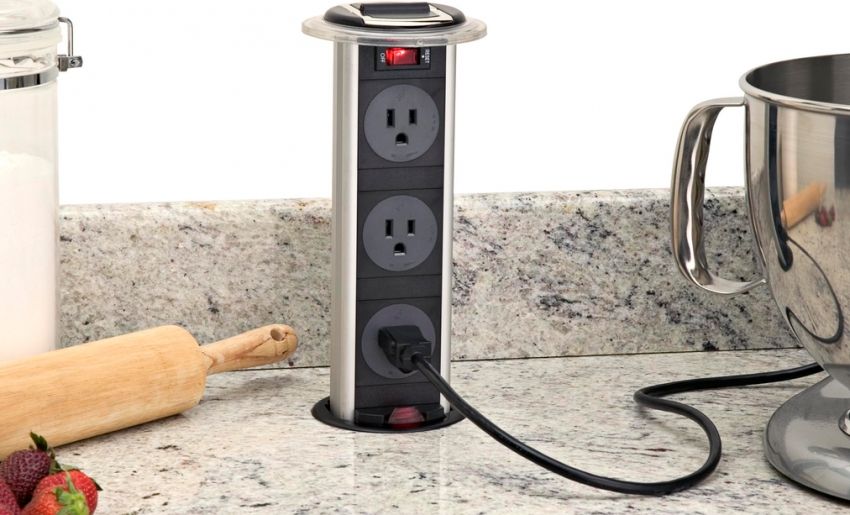
- a household appliance that will be plugged in must be at a distance of no more than 1 m from it;
- All outlets must be located so that the risk of splashing water or steam is completely excluded.
These are the minimum safety requirements that will allow you to avoid dangerous situations in the kitchen. After all, it is here that the maximum number of communications is collected, each of which should not harm the other.
What are the sockets for the kitchen: 4 popular types
There are several types of sockets, which are widely used in the process of arranging the kitchen space. Consider the advantages and disadvantages of each solution:
- Overhead sockets – this is the simplest type, which is widely used in rooms, but not very well suited for the kitchen. On the one hand, they are the most accessible and easy to install. But at the same time, they are more suitable for open postings;
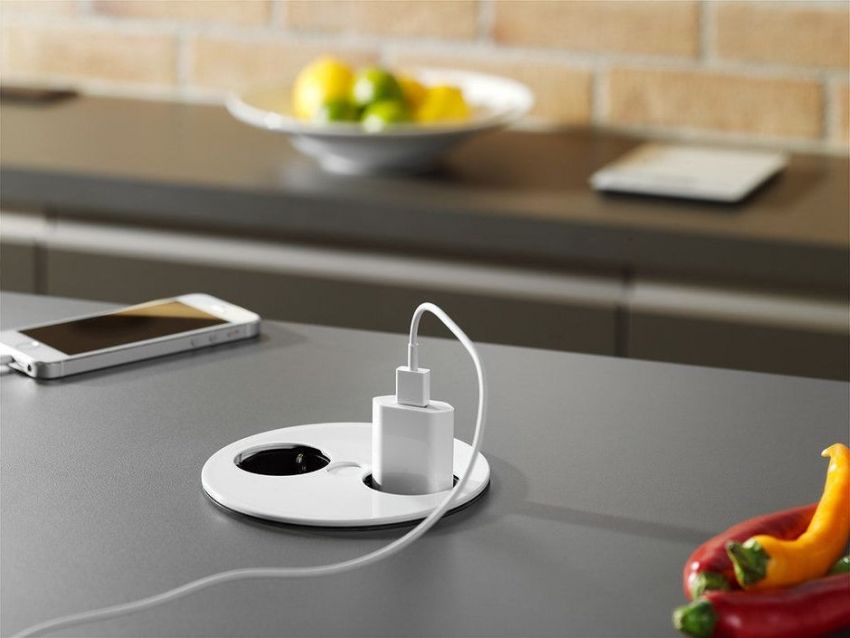
- corner sockets for the kitchen – this option is very convenient. Such elements can be placed at the junction of walls or walls and a hinged locker. In this case, you can purchase single or modular structures, which consist of two or more parts. It’s no more difficult to mount them than the most common overhead sockets, and it’s also worth buying corner sockets for the kitchen because they allow you to use the space that is usually empty;
- retractable sockets – this is a more advanced version, which is a worthy alternative to extension cords, and allow you to simultaneously connect several electrical appliances. They are usually hidden in the countertop or in the cabinet to protect them from dust and moisture;
- recessed or hidden sockets – the most aesthetic of all possible options. Usually it looks like a block of several outlets, which is built into the countertop. The attractiveness is added by the fact that usually the block is not visible until you don’t need it, and when gently pressed it comes out, allowing you to connect the devices.
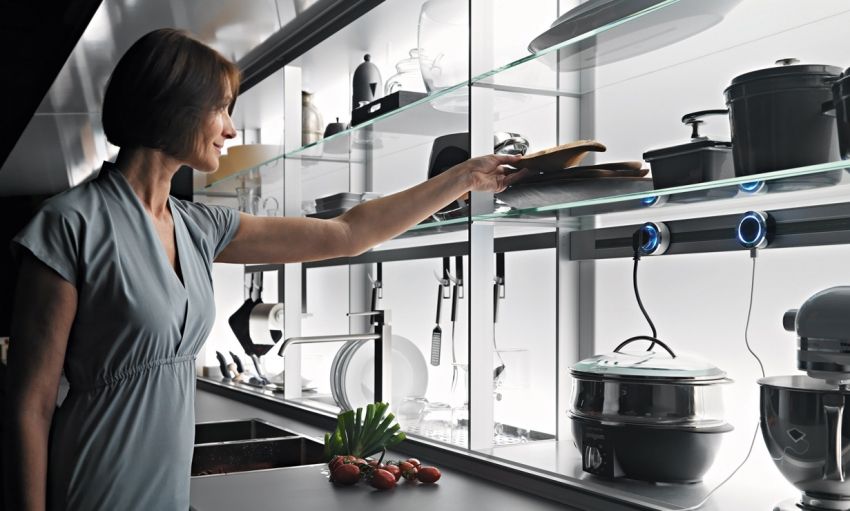
Helpful advice! In addition to traditional outlets, connectors for charging gadgets, as well as audio and video outputs can be provided in the modern unit.
Calculate the required number of outlets for the kitchen is easy. All you need to do is to think about which electrical appliances you will use and make a reserve, approximately 20-25%. Basically, the list of mandatory appliances that need power from the outlet is as follows:
- exhaust hood;
- the stove, if it is electric or has electric ignition (sometimes the gas surface is equipped with an electric oven);
- large household appliances to which the refrigerator, the washing machine, sometimes TV belongs;
- small and built-in appliances such as microwave, kettle, etc.
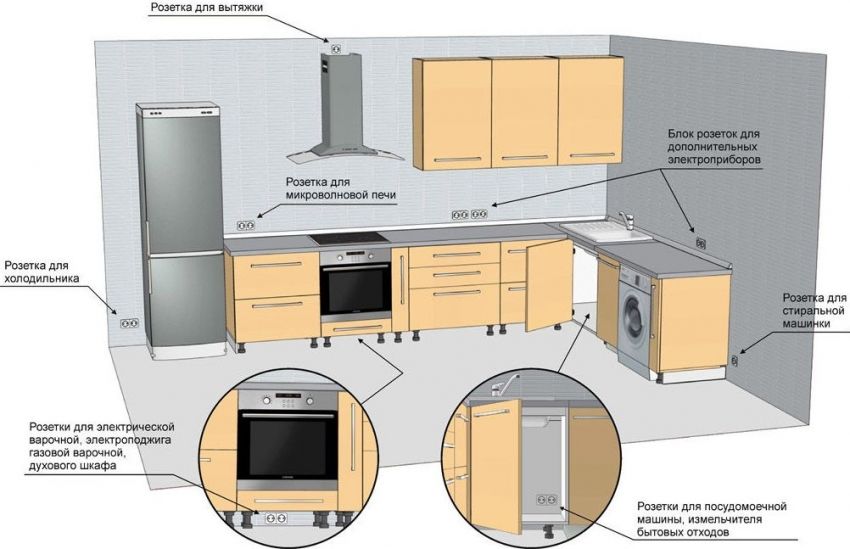
Having counted all the items, add a stock that will allow you to easily use those devices that may appear in the future. Of course, additional sockets are additional expenses, however, it should be understood that in the future just add the missing ones will not work, and in the best case, you will have to use extension cords, which will only create discomfort.
Before proceeding to the choice of places, as well as the installation of sockets, it is necessary to make some calculations that will help to do everything correctly. First of all, you need to write out all the devices that you plan to use in the near future, as well as their approximate power. Of course, the power indicators will be individual, however, as an example, we can consider the following average indicators:
- refrigerator – up to 1 kW;
- water heater – from 1.5 kW;
- cooking surface – from 1 to 1.5 kW;
- washing machine – about 1.5 kW;
- electric oven – from 2.5 kW.
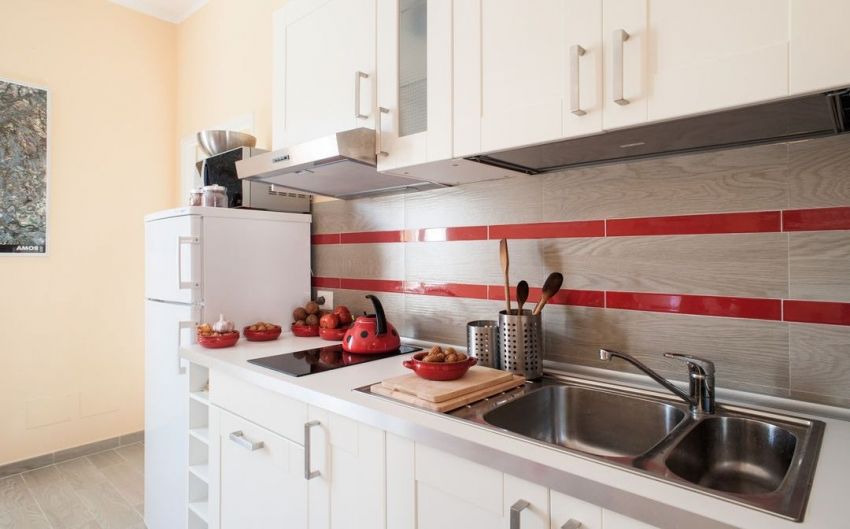
All these items are large household appliances that create the main load on the network. Small appliances, which include a microwave, blender, coffee maker, kettle, etc., as a rule, consume from 300 to 800 kW, depending on the model.
Helpful advice! If you plan to use additional equipment in the kitchen, for example, a TV or laptop, then during the calculations, they also need to be taken into account. Usually TV consumes about 200-330 watts, and a laptop 50-75 watts.
Here are a few basic rules that should guide the location of sockets in the kitchen:
- The total power of all devices that will be connected to the same outlet should not exceed the permissible. That is, you need to look in advance at the power of each device (it is indicated in the data sheet). Usually, only large appliances such as an electric kettle and a microwave oven cannot be connected to one outlet, and the other combinations are quite acceptable;
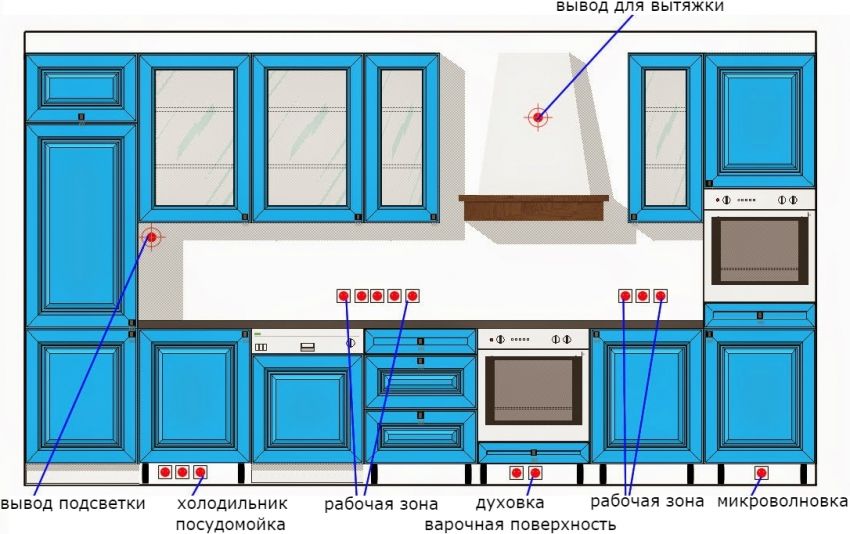
- the power lines of the sockets in the kitchen should be enough so that all the sockets are enough with a double margin. To do this, conditionally divide the space into several zones, depending on how the devices are located, and then divide the required power for their power supply into groups of sockets. By multiplying the result by two in each of the groups, you will get the most complete picture of how many sources will be needed;
- in order to provide power for large appliances, it is desirable to connect individual lines to them, the cross section of which will be suitable. This applies to electric stoves and other large devices for which individual individual automatic protection on the electric board will not interfere;
- if the device has a metal case, then it must be grounded, and sockets in this case must be connected via an RCD or differential circuit breaker;

- according to the regulations, the installation of sockets directly above electrical appliances (refrigerator, oven, hood, etc.) is strictly prohibited. They should be placed strictly on the side and at a distance of at least 20 cm;
- Another important point concerns the installation at the location of the apron. Outlets in the kitchen should rise above the worktop at least 10-15 cm to eliminate the risk of water and fat falling into them.
Important! It is strictly forbidden to install sockets directly above the stove or sink. And if pipes are located in the immediate vicinity, then all outlets must have covers and rubber seals, which, in case of a pipe break, will be able to protect them.
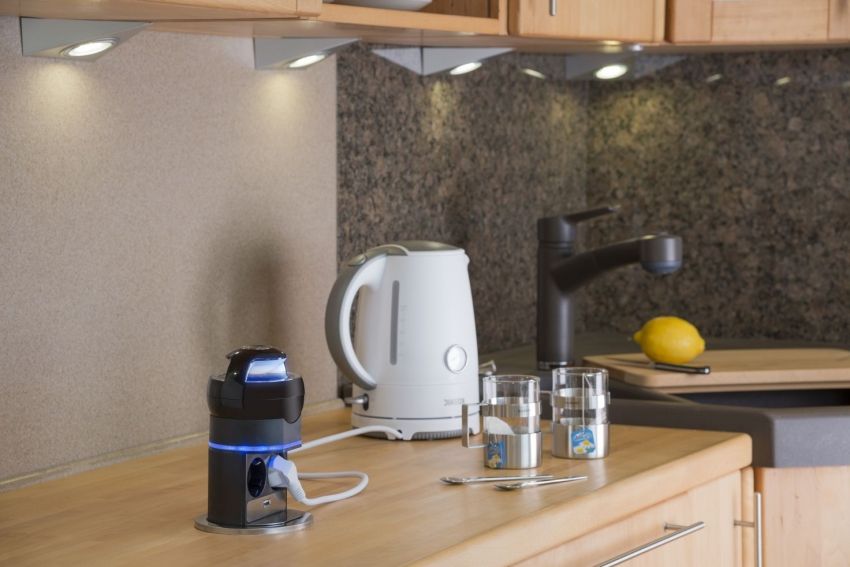
You can understand what kind of power a particular outlet is designed for by drawing attention to the label provided by the manufacturer. There are two options: 10 amps – 2.2 kW and 16 amps, which corresponds to 3.5 kW.
Proper installation of sockets in the kitchen is easiest if you use the prepared scheme. It is possible to use something that is already ready, but it is better to take the time to independently compile it, since this is the only way to take into account all the subtleties and characteristics of a particular kitchen and appliances. It is more likely to use the schemes proposed on the Internet as examples and reference points.
The ease of use of the sockets, as well as the aesthetic side of the issue, will depend on how carefully the system of location of the sockets is thought out.
Helpful advice! The height of the sockets in the kitchen on the apron should not only meet the standards, but also take into account your individual wishes. To get started, stand next to the work surface and try to reach the place where the socket will be located. Try to determine how comfortable this height is for you.

The first thing you need to know in order to create a plan of sockets on your own is the configuration of your kitchen unit. Moreover, the scheme should be as complete and detailed as possible, down to the smallest shelves and drawers. It is very important to accurately take into account all the heights and sizes of each element. Only with this approach, you can take into account the location of sockets in the kitchen for embedded appliances, as well as for small household appliances.
Helpful advice! Since sockets in many respects determine the safety of using electricity, it is worthwhile to take a responsible approach to their choice and not to resort to excessive savings. So, if retractable models seem too expensive, it is better to give preference to a simpler design than to buy a cheap fake, which will soon come to a fault.
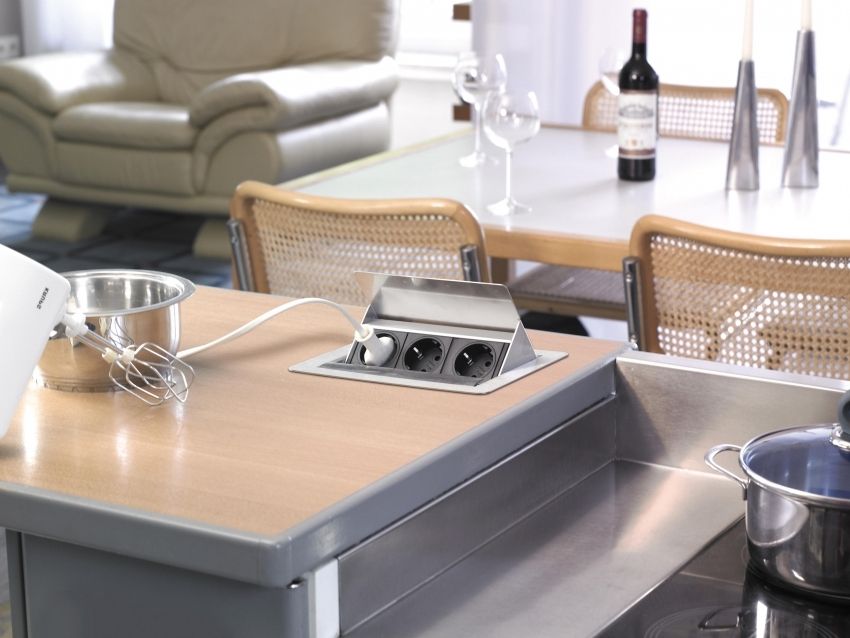
So, we can conclude that if desired, as well as relatively small investments, it is quite possible to independently equip the kitchen space in such a way that all large and small household appliances are properly placed. Of course, this will require certain skills and a scheme of sockets in the kitchen with dimensions, however, anyone who is willing to devote time to studying this issue can cope with this task.
